
General Chemistry: Principles and Modern Applications (11th Edition)
11th Edition
ISBN: 9780132931281
Author: Ralph H. Petrucci, F. Geoffrey Herring, Jeffry D. Madura, Carey Bissonnette
Publisher: PEARSON
expand_more
expand_more
format_list_bulleted
Question
Chapter 22, Problem 7E
Interpretation Introduction
(a)
Interpretation:
The probable geometric structure of
Concept introduction:
- Valence shell electron pair repulsion theory (VSEPR) predicts the geometry of the molecules depending on the number of bond pair of electrons and number of lone pair of electrons.
- Electron pair geometry includes both bonded atoms and lone pairs, while molecular geometry only considers the bonded atoms.
- The geometries corresponding to different steric number is shown − Steric number = number of bond pairs +number of lone pairs
| VSEPR GEOMETRIES | |||||
| Steric number | 0 lone pairs | 1 lone pair | 2 lone pairs | 3 lone pairs | 4 lone pairs |
| 2 |  Linear |
||||
| 3 | Trigonal planar |
Bent |
|||
| 4 | Tetrahedral |
Trigonal pyramidal |
Bent |
||
| 5 | TrigonalBipyramidal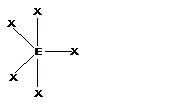 |
Seesaw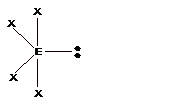 |
T-shape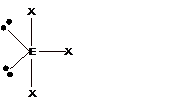 |
Linear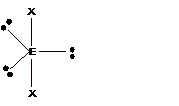 |
|
| 6 | Octahedral |
Square pyramidal |
Square planar |
T-shape |
Linear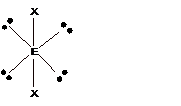 |
Interpretation Introduction
(b)
Interpretation:
The probable geometric structure of
Concept introduction:
- Valence shell electron pair repulsion theory (VSEPR) predicts the geometry of the molecules depending on the number of bond pair of electrons and number of lone pair of electrons.
- Electron pair geometry includes both bonded atoms and lone pairs, while molecular geometry only considers the bonded atoms.
- The geometries corresponding to different steric number is shown − Steric number = number of bond pairs +number of lone pairs
| VSEPR GEOMETRIES | |||||
| Steric number | 0 lone pairs | 1 lone pair | 2 lone pairs | 3 lone pairs | 4 lone pairs |
| 2 |  Linear |
||||
| 3 | Trigonal planar |
Bent |
|||
| 4 | Tetrahedral |
Trigonal pyramidal |
Bent |
||
| 5 | TrigonalBipyramidal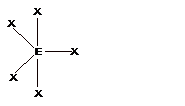 |
Seesaw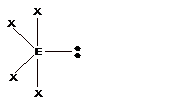 |
T-shape |
Linear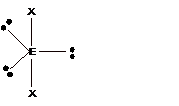 |
|
| 6 | Octahedral |
Square pyramidal |
Square planar |
T-shape |
Linear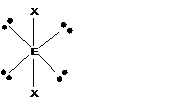 |
Interpretation Introduction
(c)
Interpretation:
The probable geometric structure of
Concept introduction:
- Valence shell electron pair repulsion theory (VSEPR) predicts the geometry of the molecules depending on the number of bond pair of electrons and number of lone pair of electrons.
- Electron pair geometry includes both bonded atoms and lone pairs, while molecular geometry only considers the bonded atoms.
- The geometries corresponding to different steric number is shown − Steric number = number of bond pairs +number of lone pairs
| VSEPR GEOMETRIES | |||||
| Steric number | 0 lone pairs | 1 lone pair | 2 lone pairs | 3 lone pairs | 4 lone pairs |
| 2 |  Linear |
||||
| 3 | Trigonal planar |
Bent |
|||
| 4 | Tetrahedral |
Trigonal pyramidal |
Bent |
||
| 5 | Trigonal Bipyramidal |
Seesaw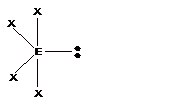 |
T-shape |
Linear |
|
| 6 | Octahedral |
Square pyramidal |
Square planar |
T-shape |
Linear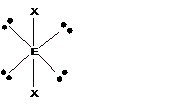 |
Expert Solution & Answer
Want to see the full answer?
Check out a sample textbook solution
Chapter 22 Solutions
General Chemistry: Principles and Modern Applications (11th Edition)
Ch. 22 - Give the formula of the stable fluride by Li, Be,...Ch. 22 - Fluorine is able to stabilize element’s in very...Ch. 22 - Prob. 3ECh. 22 - Prob. 4ECh. 22 - Prob. 5ECh. 22 - Prob. 6ECh. 22 - Prob. 7ECh. 22 - Use VSEPR theory to predict the probable geometric...Ch. 22 - Prob. 9ECh. 22 - Prob. 10E
Ch. 22 - Prob. 11ECh. 22 - Prob. 12ECh. 22 - Prob. 13ECh. 22 - Prob. 14ECh. 22 - Make a general prediction about which of the...Ch. 22 - The following properties of astatine have been...Ch. 22 - Prob. 17ECh. 22 - Prob. 18ECh. 22 - Prob. 19ECh. 22 - Prob. 20ECh. 22 - Prob. 21ECh. 22 - Prob. 22ECh. 22 - Prob. 23ECh. 22 - Prob. 24ECh. 22 - Each of the following compounds decomposes to...Ch. 22 - Ozone is a power oxidizing agent. Using ozone as...Ch. 22 - Prob. 27ECh. 22 - Prob. 28ECh. 22 - Prob. 29ECh. 22 - Prob. 30ECh. 22 - Prob. 31ECh. 22 - Prob. 32ECh. 22 - Prob. 33ECh. 22 - In water, O2(aq) is a strong base. If 100.0 mg of...Ch. 22 - The conversion of O2(g) to O2(g) can be...Ch. 22 - Prob. 36ECh. 22 - Prob. 37ECh. 22 - Prob. 38ECh. 22 - Prob. 39ECh. 22 - Prob. 40ECh. 22 - Prob. 41ECh. 22 - Joseph Priestley, e British chemist, was credited...Ch. 22 - Give an appropriate name to each of theb following...Ch. 22 - Prob. 44ECh. 22 - Give a specific example of a chemical equation...Ch. 22 - Prob. 46ECh. 22 - Prob. 47ECh. 22 - Prob. 48ECh. 22 - Prob. 49ECh. 22 - Prob. 50ECh. 22 - Prob. 51ECh. 22 - Prob. 52ECh. 22 - Prob. 53ECh. 22 - Prob. 54ECh. 22 - Prob. 55ECh. 22 - Prob. 56ECh. 22 - Prob. 57ECh. 22 - Prob. 58ECh. 22 - Prob. 59ECh. 22 - One reaction that competes with reaction (22.41),...Ch. 22 - Prob. 61ECh. 22 - Prob. 62ECh. 22 - Draw plausible Lewis structures for a....Ch. 22 - Both nitramide and hyponitrous acid have the...Ch. 22 - Prob. 65ECh. 22 - Prob. 66ECh. 22 - Prob. 67ECh. 22 - Prob. 68ECh. 22 - Prob. 69ECh. 22 - Prob. 70ECh. 22 - Use data from Table 7.2 (page 273) to calculate...Ch. 22 - Prob. 72ECh. 22 - Prob. 73ECh. 22 - Prob. 74ECh. 22 - Prob. 75ECh. 22 - What volume of H2(g) at 25C and 752 mmHg is...Ch. 22 - Prob. 77ECh. 22 - How many grams of CaH2(s) are required to generate...Ch. 22 - Prob. 79ECh. 22 - On the basis of molecular orbital theory, would...Ch. 22 - Prob. 81IAECh. 22 - Prob. 82IAECh. 22 - Prob. 83IAECh. 22 - The photograph was taken after a few drops of a...Ch. 22 - Prob. 85IAECh. 22 - Prob. 86IAECh. 22 - Prob. 87IAECh. 22 - Despite the fact that it has the higher molecular...Ch. 22 - The text mentions that ammonium perchlorate is an...Ch. 22 - Prob. 90IAECh. 22 - Prob. 91IAECh. 22 - Prob. 92IAECh. 22 - Refer to Figure 11-25 to arrange the following...Ch. 22 - Prob. 94IAECh. 22 - Prob. 95IAECh. 22 - Estimate the percent dissociation of CI2(g) into...Ch. 22 - Prob. 97IAECh. 22 - The structure of N(SiH2)2 involves a planar...Ch. 22 - Prob. 99IAECh. 22 - Refer to the Integrative Example on page 1082....Ch. 22 - The bond energies of CIz and 159kJmol1 are 243 and...Ch. 22 - Prob. 102IAECh. 22 - Prob. 103IAECh. 22 - Prob. 104IAECh. 22 - Prob. 105IAECh. 22 - The heavier halogens (CI, Br, and I) form...Ch. 22 - Prob. 107IAECh. 22 - Chemists have successfully synthesized the ionic...Ch. 22 - Prob. 109IAECh. 22 - Various thermochemical cycles are being explored...Ch. 22 - The decomposition of aqueous hydrogen peroxide is...Ch. 22 - Both in this chapter and in Chapter 19, we have...Ch. 22 - Prob. 113FPCh. 22 - The so-called pyroanions, X2O7n+ , form a series...Ch. 22 - A description of bonding in XeF2 based on the...Ch. 22 - Prob. 116FPCh. 22 - Prob. 117SAECh. 22 - Prob. 118SAECh. 22 - Prob. 119SAECh. 22 - Which of the following can oxidize Br to Br2 in...Ch. 22 - Prob. 121SAECh. 22 - Prob. 122SAECh. 22 - Prob. 123SAECh. 22 - Prob. 124SAECh. 22 - Prob. 125SAECh. 22 - Prob. 126SAECh. 22 - Prob. 127SAECh. 22 - Give a practical laboratory method that you might...Ch. 22 - Prob. 129SAECh. 22 - Prob. 130SAECh. 22 - Prob. 131SAECh. 22 - Prob. 132SAECh. 22 - Prob. 133SAECh. 22 - Prob. 134SAECh. 22 - Prob. 135SAE
Knowledge Booster
Similar questions
- How can the paramagnetism of O2 be explained using the molecular orbital model?arrow_forwardDefine the bonding that exists in metals and how this model explains some of the unique physical properties of metals. What are metal alloys? Identify the two main types of alloys, and describe how their structures differ. Give several examples of each type of alloy.arrow_forwardWhat volume of 0.250 M H2SO4 solution is required to neutralize a solution that contains 5.00 g of CaCO3?arrow_forward
- What is the molecular structure of each of the following molecules? You may wish to review the chapter on chemical bonding and molecular geometry. (a) XeF2. (b) XeF4. (c) XeO3. (d) XeO4. (e) XeOF4arrow_forwardWhat is the oxidation state of the noble gas in each of the following? You may wish to review the chapter on chemical bonding and molecular geometry. (a) XeO2F2. (b) KrF2. (c) XeF3+. (d) XeO64-. (e) XeO3arrow_forwardWhy is SnCl4 not classified as a salt?arrow_forward
- Complete and balance the following chemical equations: (a) hardening of plaster containing slaked lime. Ca(OH)2+CO2 (b) removal of sulfur dioxide from the ?ue gas of power plants. CaO+SO2 (c) the reaction of baking powder that produces carbon dioxide gas and causes bread to rise. NaHCO3+NaH2PO4arrow_forwardWhat volume of 0.200 M NaOH is necessary to neutralize the solution produced by dissolving 2.00 g of PCl3 is an excess of water? Note that when H3PO3 i5 titrated under these conditions, only one proton of the acid molecule reacts.arrow_forwardHalogens combine with one another to produce interhalogens such as BrF3. Sketch a possible molecular structure for this molecule, and decide if the FBrF bond angles will be less than or greater than ideal.arrow_forward
arrow_back_ios
arrow_forward_ios
Recommended textbooks for you
 Chemistry & Chemical ReactivityChemistryISBN:9781133949640Author:John C. Kotz, Paul M. Treichel, John Townsend, David TreichelPublisher:Cengage Learning
Chemistry & Chemical ReactivityChemistryISBN:9781133949640Author:John C. Kotz, Paul M. Treichel, John Townsend, David TreichelPublisher:Cengage Learning Chemistry & Chemical ReactivityChemistryISBN:9781337399074Author:John C. Kotz, Paul M. Treichel, John Townsend, David TreichelPublisher:Cengage Learning
Chemistry & Chemical ReactivityChemistryISBN:9781337399074Author:John C. Kotz, Paul M. Treichel, John Townsend, David TreichelPublisher:Cengage Learning Chemistry by OpenStax (2015-05-04)ChemistryISBN:9781938168390Author:Klaus Theopold, Richard H Langley, Paul Flowers, William R. Robinson, Mark BlaserPublisher:OpenStax
Chemistry by OpenStax (2015-05-04)ChemistryISBN:9781938168390Author:Klaus Theopold, Richard H Langley, Paul Flowers, William R. Robinson, Mark BlaserPublisher:OpenStax Chemistry: The Molecular ScienceChemistryISBN:9781285199047Author:John W. Moore, Conrad L. StanitskiPublisher:Cengage Learning
Chemistry: The Molecular ScienceChemistryISBN:9781285199047Author:John W. Moore, Conrad L. StanitskiPublisher:Cengage Learning Chemistry: An Atoms First ApproachChemistryISBN:9781305079243Author:Steven S. Zumdahl, Susan A. ZumdahlPublisher:Cengage Learning
Chemistry: An Atoms First ApproachChemistryISBN:9781305079243Author:Steven S. Zumdahl, Susan A. ZumdahlPublisher:Cengage Learning ChemistryChemistryISBN:9781305957404Author:Steven S. Zumdahl, Susan A. Zumdahl, Donald J. DeCostePublisher:Cengage Learning
ChemistryChemistryISBN:9781305957404Author:Steven S. Zumdahl, Susan A. Zumdahl, Donald J. DeCostePublisher:Cengage Learning

Chemistry & Chemical Reactivity
Chemistry
ISBN:9781133949640
Author:John C. Kotz, Paul M. Treichel, John Townsend, David Treichel
Publisher:Cengage Learning

Chemistry & Chemical Reactivity
Chemistry
ISBN:9781337399074
Author:John C. Kotz, Paul M. Treichel, John Townsend, David Treichel
Publisher:Cengage Learning

Chemistry by OpenStax (2015-05-04)
Chemistry
ISBN:9781938168390
Author:Klaus Theopold, Richard H Langley, Paul Flowers, William R. Robinson, Mark Blaser
Publisher:OpenStax

Chemistry: The Molecular Science
Chemistry
ISBN:9781285199047
Author:John W. Moore, Conrad L. Stanitski
Publisher:Cengage Learning

Chemistry: An Atoms First Approach
Chemistry
ISBN:9781305079243
Author:Steven S. Zumdahl, Susan A. Zumdahl
Publisher:Cengage Learning

Chemistry
Chemistry
ISBN:9781305957404
Author:Steven S. Zumdahl, Susan A. Zumdahl, Donald J. DeCoste
Publisher:Cengage Learning